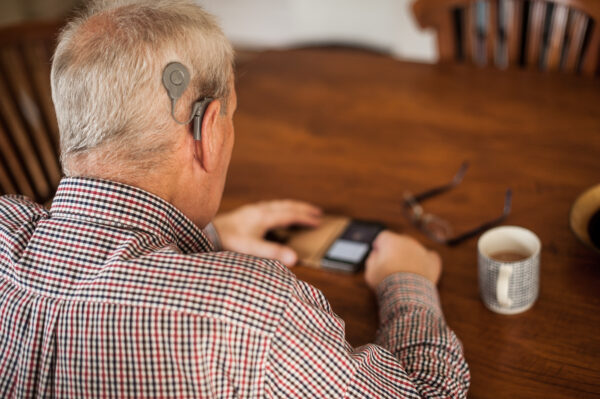An important step in improving your hearing is to create a daily strategy to hear best with your cochlear implant. You’re probably already doing this already without even realizing it—identifying new sounds or words as you go about your daily activities.
Why is listening practice important?
Dedicating time to doing regular listening and rehab exercises after initial activation is shown to be beneficial and can help you get the most out of your Nucleus® Nexa™ Sound Processor. Clinical studies also suggest that regularly doing rehab at home continues to benefit cochlear implant recipients who have been fitted for years.12
“The day after switch on, I felt indescribable joy to be given the gift of sound. As a new cochlear implant recipient, I wanted to experience being able to participate in conversations. However, I quickly came to realise that I needed to retrain my brain to listen as that part of the brain had not been stimulated for many years.” – Diane, cochlear implant recipient
Before you start
It’s important to understand that listening practice can take time before you start to see improvements, so start slowly and take breaks when you need to. It helps to practice when you feel fresh and relaxed.
If you’re just starting, find a comfortable and quiet room to practise. Depending on the exercise, you may want to sit facing your practice partner so you can see their face easily.
Incorporating your practice into your daily routines also helps, even with simple activities like listening to podcasts while doing chores, listening to the radio or even sitting in a noisy café and noticing the different voices and sounds around you. Don’t be afraid to ask for support from those around you—encouragement is always a great motivator.
Simple listening activities to get you started
1. Read along: Ask family or friends to read to you or you can use an audiobook to follow along with the written book. This can be a good way to recognize the rhythm and pattern of sentences as well as the sound of individual words.
2. Listen to podcasts: You can choose the volume and speed that you listen to, as well as different accents as you improve in your practice. You can also watch Ted Talks® YouTube videos with the closed captioning on. These are great sources for different accents.
3. Keep a diary: Start a listening diary to note down your experiences. You can jot down new words or sounds that you’ve recognized. It’s a helpful way to track your progress and a helpful reminder of questions or comments when you see your hearing health professional.
4. Note sounds around the house: Try identifying sounds like the fridge humming, microwave beeping, the vacuum or clothes dryer. Anything you hear and recognize is worth noting.
5. Note sounds outside: From the sound of wind or rain, birds chirping or the waves crashing, see what different volumes and types of sounds you notice.
6. Go shopping and socialize: Every experience in the world gives you an opportunity to notice different voices and accents. Try and notice the difference between a man’s voice and a child, for example. It’s a fun excuse to try and eavesdrop on conversations around you!
7. Watch movies or videos: We recommend you try watching movies or shows with a storyline that you’re familiar with. Switch the captions on to help follow the words.
8. Stream audio to your sound processor: Streaming audio directly from your compatible* phone, tablet, laptop or TV can help with clarity of speech. (Remember, if you need help pairing your devices, you can find Cochlear how-to videos here.)
We’ve listed a few strategies here, but they might inspire you to discover other activities—find what works for you.
We asked some of our recipients to share their advice on listening practice, to help encourage and reassure you.
“My wife and I would go through my work rosters and read out the names and towns where my people worked. I can read lips very well. So, my wife would put a piece of paper up in front of her lips so I wouldn’t cheat!” – Tom, cochlear implant recipient
“I spent about two months using the audiobooks, building up and building up and then I removed the captions. The pace was slow, the diction was clear and concise, and the words were there—it was just what I needed.” – Charlotte, cochlear implant recipient
For additional rehabilitation resources, click here
- Adult Cochlear Implant Home-Based Auditory Training Manual: Post lingual Hearing Loss, Belinda Henry, Karen Pedley, Qian-Jie Fu, July 2015, produced by Cochlear Ltd (N585130-585133 ISS2 JUL15).
- Fu, QJ., Galvin, JJ 3rd. Maximizing cochlear implant patients’ performance with advanced speech training procedures. Hear Res. 2008 Aug; 242 (1-2):198-208

